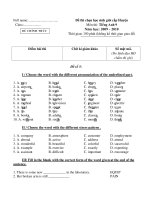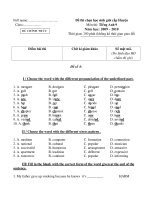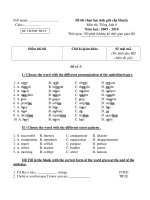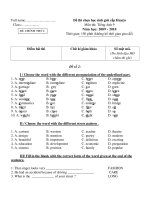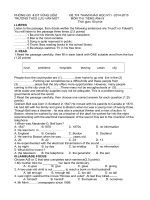topic thi Tiếng anh B1 cao học
Bạn đang xem bản rút gọn của tài liệu. Xem và tải ngay bản đầy đủ của tài liệu tại đây (73.52 KB, 6 trang )
TOPIC ENGLISH OF PUBLIC ADMINISTRATION
Unit 1: Administration and public administration
1. The term “administration” has a long history. Some authors think that the term
coincides with the formation of the state long ago. Dunsire, A. wrote “the
classical Latin verb had two distinct senses: to help, assist, or serve …, and to
manage, direct, or govern …” We can see a combination of the two main
meanings, “directing” and “assisting” at the same time.
2. Although originally “administer” and “manage” had some similar meanings
such as “getting things done”, “administration” is a richer term and has more
meanings. Baker wrote: “It (administration) is more usually found in the public
sector than the private and, in general, carries an idea, not of control, but of
directing and coordinating things on behalf of other people or authorities. It is
often connected with some idea of service”.
3. Although the notion of public administration is as old as government,
understanding about it still differs among different people. It can be seen as an
art, a science or a profession. Although many people do not always think of
themselves as public administrators, identifying themselves in their specific
professions, they provide public services.
4. There are many different definitions of public administration. Fletcher
explained that “Public administration can be used to mean: (1) The activity of
public servants, (2) The structure of executive government: that is the
institutions and patterns of relationships through which the activity of public
servants is carried on, (3) The study of 1 and 2”. As such, public administration
focuses mainly on the institutions, organizational structures and decision/
implementation processes of government.
5. In Vietnam, this definition is used: (1) Public administration is a power named
“administrative power”. The power to organize and manage the state
administrative machinery; (2) A system of public bodies; (3) A set of
institutions; and (4) The action of public servants.
UNIT 2: THE SOCIALIST REPUBLIC OF VIETNAM:
The political system of Vietnam
1. The Socialist Republic of Vietnam is an independent and sovereign
country enjoying unity and territorial integrity.
2. The Socialist Republic of Vietnam is a State of the people, from the
people, and for the people
3. The State guarantees and promotes the people’s mastery in all fields,
and severely punishes all acts violating the interests of the motherland and the
people.
The Communist Party of Vietnam is the force leading the State and
society. All Party organizations operate within the framework of the Constitution
and the law.
Activity 12: Text 2
The socialist republic of Vietnam
1. The Socialist Republic of Vietnam is the unified state of all nationalities
living on the territory of Vietnam.
2. The State carries out a policy of equality, solidarity and mutual
assistance among all nationalities, and forbids all acts of national discrimination
and division.
3. Every ethnic group has the right to use its own language and system of
writing.
4. The State carries out a policy of comprehensive development and
gradually raises the material and spiritual living conditions of the national
minorities.
5. The people make use of State power through the National Assembly
and the People’s Councils, which represent the will and aspirations of the
people, are elected by them and responsible to them.
6. Democratic centralism is the principle governing the organization and
activity of the National Assembly, the People’s Councils, and all other state
organs.
Exercise 1: Complementary reading
Read the following text carefully, then answer the questions that follow.
1. The Vietnam Fatherland Front and its member organizations constitute
the political base of people’s power.
2. The trade union, being the socio – political organization of the working
class and the toiling people.
3. The citizen is duty – bound to help protect public property, legitimate
civic rights and interests, maintain national security and social order, and
organize public life.
UNIT 3: THE LEGISLATURE OF THE SRV
Text 1:
The Legislature of the Socialist Republic of Viet nam
1. In the Socialist Republic of Vietnam, the only organ with constitutional
and legislative powers is the National Assembly.
2. According to the 1992 Constitution, the country’s President and
specified state organs may present draft laws to the National Assembly.
3. Laws, resolutions and decisions taken to amend the Constitution of the
National Assembly must be approved by at least two – thirds of its total
membership.
4. The Permanent Committee of the National Assembly is its the power to
interpret the Constitution, the laws, and decree – laws.
5. Laws, decree – laws and changes to the Constitution are announced
officially by the country’s President.
Text 2 : The Legislature of the United Kingdom
1. The main legislative body in Britain is the Parliament.
2. The British Parliament consists of two houses: the House of Commons,
and the House of Lords. The Queen is the formal head of Parliament
3. The bill must have three readings in order and receives Royal Assent
from the Queen become a law.
4. Britain is a constitutional monarchy without a written constitution.
5. Parliament has direct and exclusive control over legislation.
UNIT 4: THE GOVERNMENT OF THE SRV
Activity 5: Tex 1
The Government of SRV
1. The Government is the executive body of the National Assembly and
the highest state administrative body of the SRV.
2. The Government assumes the unified administration of the
implementation of all political, economic, cultural, social, national defense,
security and external activities of the State;
3. The Government is accountable to the National Assembly, the Standing
Committee of the National Assembly and the President of the State.
4. The Government Structure consists of:
- Ministries.
- Ministerial level agencies.
5. The establishment or abolition of a ministry or a ministerial level
agency and high –ranking positions of the Government are appointed by the
National Assembly.
The Government of the UK
1. The main functions of the Primier Minister:
The Prime Minister is the head of the Government and presides over meetings of
the Cabinet; by convention he is always a Member of the House of Commons.
He is appointed directly by the Crown and is the leader of the political party;
2. The Cabinet is the nucleus of government; its members consist of a small
group of the most important ministers who are selected by the Prime Minister.
The size of the Cabinet is today about 23 and its principal function, much of
work being carried out in committee, is to determine, control and integrate the
policies of the government for submission to Parliament.
3. The central government ministries and departments of the government
policies and have powers and duties conferred on them by legislation, and
sometimes, under the Royal Prerogative.
UNIT 5: THE JUDICIARY IN THE STATE MACHINERY OF VN
The Judiciary in the SRV: the People’s Court
1. It is the duty of the People’s court and the People’s Office of Supervision and
Control to protect the socialist regime and the people.
2. The judicial organs of the SRV are: The Supreme People’s Court, the local
People’s Court, the Military Tribunals and other tribunals established.
3. The tenure of office of the President of the Supreme People’s Court as well as
all other matters concerning their appointment and conditions of service, will be
determined by law. .
4. The People’s Courts shall try their cases collegially and their decisions shall
conform to the will of the majority. The right of the defendant to be defended is
guaranteed.
UNIT 6: LOCAL AUTHORITIES IN VIETNAM
Topic: Local authorities in Vietnam
1. In the Socialist Republic of Vietnam, local authorities refer to the
People’s Councils and the People’s Committees.
2: The People’s Council is the organ of state power whose function is to
pass the resolutions on the implementation of various measures at the local
level.
3: The People’s Committee is the executive organ of the People’s Council
and the state administrative organ at the locality, responsible for implementing
the Constitution, the law, and the formal written orders of superior state organs
and the resolutions of the People’s Council.
The chairman of the People’s Committees can suspend or abrogate the
wrong decitions of the People’s Committees of a lower rank and can suspend the
wrong resolutions of the People’s Council of a lower rank and propose to the
People’s Council at own level to abrogate such resolutions.
Text 2: The Structure of local government in Canada
1. The federal and provincial governments have specific powers which are
guaranteed by the Constitution.
Local governments have powers that have been granted to them by their
provincial governments.
2. Local governments in Canada include municipal corporations and a
variety of boards, commissions and other special purpose bodies.
3. The importance of local governments is make possible administrative
decentralization and provide different programs vital to the day-to-day life of
citizens.
4. The structure of local government in Canada is very complex and
diverse. Most Canadian citizens are under the jurisdiction of two levels of
municipal government.
5. The types of Municipal councils in Canada consist of a head and a
number of councillors.
6.The three main roles of the Council are: (1) representative, (2) policy
making and (3) management.
7. The staff emloyed in the municipal councils are experts in different
fields.
UNIT 7: GOVERNANCE AND PUBLIC ADMINISTRATIONS
Text 1: governance, development and reform
1.Governance and development are currently viewed as intertwined.
2. The development efforts are undertaken in the contexts of strategies to
achieve political stability, institution-building, popular participation and
advocating human rights.
3. The reform of government and improvement of governance often go
hand in hand with reform and improvement of the economy.
4. The only a reformed government and improved governance can provide
a reasonable amount of political stability, political and economic guidelines.
5. The only good government that is likely to institutionalize democracy
through fair elections, provide an adequate system of polecies for popular.
UNIT 8: DEFINING MANAGEMENT
1. Management has been callled “the art of getting things done through
people”.
2. Management is the process of planning, organizing, leading and
controlling a members and organization’s resources to achieve stated
organizational goals.
3. A process is a systematic way of doing things.
4. Planning implies that managers think through their goals and actions in
advance.
5. Organizing means that managers co-ordinate the humand and material
resources of the organization.
6. Leading means that directing and influencing subordinates, getting
others to perform essential tasks.
7. Controlling means that setting things right.
8. A managers use all the resources of the organization –its finances,
equipment anf information as well as its people – to attain their goals.




